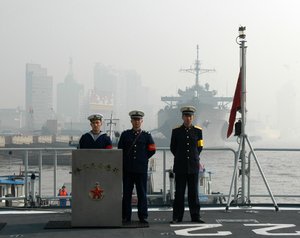Bring out the scientist with Aeromax's Rocket Science Lab Coat
Edit The Examiner 30 Apr 2016
Kids get all the good stuff -- especially when it's Halloween or anytime they're wearing a coat, they can have fun stuff showing it off. Aeromax is a good example as to doing this well because they make clothing that looks as good to the kid wearing it as to others looking on. First up is the Rocket Science Lab Coat. It’s a unisex kind of thing because frankly a lab coat doesn’t really have a gender equation....
Fashion Q&A;: Carol McMorris, owner of Armstrongs
Edit Scotsman 30 Apr 2016
CAROL McMorris, owner of Edinburgh vintage clothing institution Armstrongs, opens up on her wardrobe to Gaby Soutar. What's the last piece of clothing you bought? ... I love the clothes at Zara as they are high fashion, yet still affordable ... Their clothes are unique and quirky, often featuring lush prints....
Burglars in the garb of 'vendors'
Edit The Times of India 30 Apr 2016
When some alert policemen at Vasant Kunj noticed a group of fruit and vegetable vendors donning branded and high-end clothes, they became suspicious ... Eight customized designer shervanis, 20 high-end coats, 25 branded pants and 50 shirts were found in their possession along with 30 mobile phones and other valuables and cash....
Create an outdoor room with a pergola
Edit Denver Post 30 Apr 2016
She's designing a garden that will feature a $32,000 powder-coated steel pergola ... For more shade, some people put shade cloth on it, or we build pergolas with multiple layers of lumber or a lattice on top." ... We powder-coat all metal components and add a clear powder coat over top for protection ... Aluminum holds the powder coat just fine and will last a heck of a long time....
Prince's 'Purple Rain' jacket up for auction
Edit Naples Daily News 30 Apr 2016
Real-time updates on the latest news in the investigation into his death and tributes. 2.12 p.m. ET ... Profiles in History publicist Jeff Hare confirmed the auction news to USA TODAY ... Maddalena called the coat "the most important piece of screen-worn Prince clothing that's ever come up for auction" and said that the asking price ranges from $6,000 to $8,000, though it’s expected to sell for a significantly higher figure ... ET....
Axalta Starts Expanded Resin Production Facility in Mexico
Edit Topix 30 Apr 2016
Axalta Coating Systems has started production at its expanded resin manufacturing facility located at its Tlalnepantla campus outside Mexico City. The investment to expand infrastructure will enable the company to support its customers with the latest coating technologies that are used in a wide variety of the company's liquid coatings ... ....
Dolly Parton Fans Can Watch Her Pigeon Forge Homecoming Parade Live On Facebook
Edit Inquisitr 30 Apr 2016
Dolly Parton’s hit TV movie, Coat of Many Colors, focused on her mother and father, played by Jennifer Nettles and Ricky Schroder ... Dolly Parton was also honored for Coat of Many Colors at the 2016 ACM Awards with the Tex Ritter award ... Coat of Many Colors, based on Dolly’s hit song by the same name, was the first of a three-movie deal with NBC....
Marco milliner creates architecture styled to stun, and Derby wearers love them
Edit Naples Daily News 30 Apr 2016
The stars seemed to have aligned perfectly for Diane Shagott's second career.. She was an engineer by trade, a person with design logic and measurement skills ... Most important ... Milliner, not hatmaker ... And what I liked about it was that you could see Edith (star Laura Carmichael) mature and become wealthier by her clothes and hats," Shagott said. "A coat is a coat, but hats can say so many kinds of things.". --- ... --- ... 5-8 p.m ... ....
Textile sector seeks government support to boost exports
Edit Deccan Herald 30 Apr 2016
Total exports of textiles and clothing in 2015-16 stood at $40 billion ... The country’s total exports of textiles and clothing in 2015-16 stood at $40 billion as against $41.4 billion in 2014-15, a decline of 3.4% ... India has already lost market share to Pakistan in 19 textiles and 18 clothing products during 2014 due to the preferential access extended by EU to that country under the GSP Plus Scheme....
Glenn Beck’s Donald Trump Joke Will Make You Lose That Craving for Cheetos (Video)
Edit The Wrap 30 Apr 2016
If your fetishes lean toward burly guys coating themselves in Cheetos, has Glenn Beck got a Donald Trump joke for you. “What are you talking about,” you say, which is a perfectly reasonable response ... . That’s right, folks ... Also Read ... Beck opted to coat himself in original flavor, and used the “face-press” approach to Cheetos application ... Also Read ... Also Read....
Man abandoned 30 years ago tries to find his birth family
Edit Deseret News 30 Apr 2016
ANCHORAGE, Alaska — Nobody knows just how long the baby lay there that September night in 1986 ... Around 9 p.m., an anonymous caller told 911 dispatchers there was a baby near a clothes donation bin outside the Salvation Army, the one just off the Glenn Highway ... The baby was still coated with afterbirth ... "It was real young," one of the teenagers later told a newspaper reporter ... "9-4-86." ... "He was found by a clothes donation bin."....
NEET: CBSE issues strict dress code; rigorous checking of candidates
Edit DNA India 30 Apr 2016
--> ... Students cannot wear shoes but wear sandals or slippers ... The prescribed clothing for the exam is light clothes so that they won't be able to hide any instruments or communication devices ... Those who are wearing any religion-mandated clothing have to report at 8.30 am so that they can be checked thoroughly. dna Web Team. ....
Duchess of Cambridge portrait photos go on public display
Edit Belfast Telegraph 30 Apr 2016
Share Go To. In a black-and-white close-up shot, the Duchess is wearing a black fedora hat from Beyond Retro and a charcoal brown double-breasted suede coat and white shirt, both from Burberry ... The latest photos of the Duchess were styled by British Vogue fashion director Lucinda Chambers and a colour image of the Duchess in the brown Burberry coat and fedora will adorn the cover of the magazine's June centenary issue ... Vogue 100 ... ....
- 1
- 2
- 3
- 4
- 5
- Next page »









